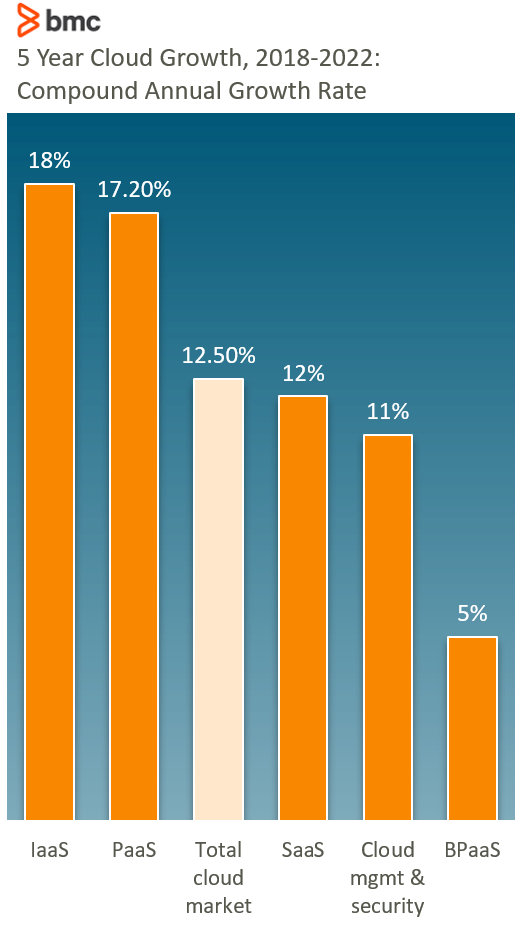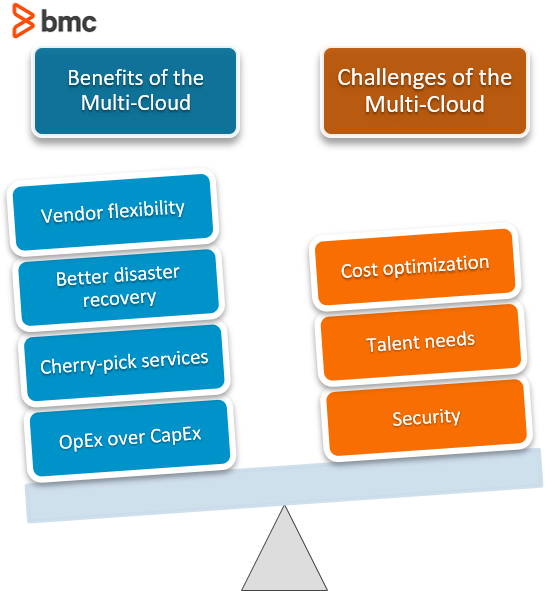What Resources Dell Needs To Implement Multi Vendor Support Services
To say that cloud adoption has been accelerating might exist an understatement. Enterprises are after what the cloud provides: speed, agility, simplicity, and lower costs. Gone are the days of managing an expensive data centre.

Though IT managers dear cloud benefits, diverse studies testify that that fear of vendor lock-in—being stuck with a vendor who no longer suits your needs—is real for a lot of companies. And this fright is growing with each passing twelvemonth, which may hinder the agility and speed you need to thrive.
The best style to alleviate these concerns? Implementing a multi-deject strategy.
Earlier the cloud even existed, companies used multiple database vendors. This strategy isn't new, we're just moving it onto the cloud. Allow's take a wait at:
- The multi-cloud
- Multi-cloud strategy
- Why you'd employ this approach
- Benefits of the multi-cloud
- Challenges
- Data prophylactic
- How to cull
- Additional resources
What is the multi-cloud?
Multi-cloud is the practice of using more than one deject platform in your cloud approach. Information technology isn't a kind of technology, just an arroyo. If you are using more than one cloud or cloud provider, it's multi-cloud.
Like shooting fish in a barrel.
(Empathize and compare public, private & hybrid clouds .)
What is a multi-cloud strategy?
A multi-cloud strategy is the intention and implementation of multi-cloud. Information technology's choosing to be in the multi-cloud on purpose—not by default.
For instance, many companies first move into the cloud tepidly, one pocket-sized service or awarding at a time. Presently, this becomes unwieldy and you have to make clean up your cloud sprawl. You need a strategy.
Strategizing for the multi-cloud, as we'll evidence, means reflecting on what your needs are and what vendor aligns with them best. For instance, the difference might be betwixt homogenous and heterogenous clouds:
- A homogenous deject may include several unlike clouds, just all from the same vendor.
- A heterogenous cloud, on the other hand, could mean three public clouds from iii vendors.
They're all multi-deject strategies, but one will work ameliorate for you than others.
Why would I use a multi-cloud approach?
Every twenty-four hour period, every company uses diverse types of data and various applications. Virtually cloud vendors specialize in 1 expanse, so existence able to use multiple clouds allows companies the agility they need. For example, with a multi-cloud approach, you tin take:
- Highly available apps existing in 1 platonic cloud solution.
- Highly sensitive data that y'all don't demand to access often in a different cloud solution. This ane might be slower simply more than secure—and that's OK!
A jack-of-all-trades is a main of none, maybe? That's really fundamental to why multi-deject strategies are growing in popularity. Just like you are an expert in your surface area, you lot want an expert in cloud services supporting you. At that place is no reason to be locked into a service that cannot evolve with the data it handles.
Beingness locked-in can be a existent challenge for any company. Non but do multi-cloud approaches escape lock-ins, but you tin can also get a lot of specific benefits.

Benefits of a multi-deject surroundings
Moving to a new system can exist daunting. Businesses worry virtually handing data over to what are essentially unknown entities.
Nevertheless, at that place are many advantages to this blazon of strategy.
Vendor flexibility = no lock-in
Never put all your deject eggs in 1 basket. If your vendor changes its strategy, service level agreements (SLAs), or pricing model, it is best to be able to movement quickly. Moving in and out of the cloud is expensive, time-consuming, and risky—something to avoid.
Instead, by using a mix of vendors, you maintain your negotiating ability, leanness, and agility. This hazard management strategy will ensure that you accept control of your data through needed flexibility.
Improved disaster recovery
Multi-cloud backups let for better backups and amend backup access. Even if one cloud service goes downward, you can rely on other providers to still take your important data safe.
(Explore cloud disaster recovery best practices.)
Reddish-selection services you demand
No single cloud provider has the best services for everything, then it is smart to tailor the best service for your situation. You might even have one process in your workflow that requires a dedicated cloud service.
Decrease capital letter expenditures
Data centers require lots of infrastructure, hardware, and fifty-fifty power supplies. These items are expensive to purchase outright. The more than of these y'all have, the less free-flowing majuscule you have to run day-to-day business operations. The cloud is a vital way to free upwards CapEx spending in favor of more than nimble OpEx spend.
Challenges of a multi-deject approach
A multi-deject strategy tin can be more than circuitous to run compared to the traditional single-cloud arroyo. The entire process is highly dependent on expert planning.
Businesses should familiarize themselves with the advantages and disadvantages when making optimal choices.
Talent needs
Having the right people for the job is crucial. A multi-cloud environment is more involved and you need to have people who understand the structures. Near cloud interfaces vary, so i person knowing every organization is rare.
As more than companies fully embrace deject infrastructure, having the right cloud talent is vital. You lot might consider cloud-specific specialists—AWS, Azure, and speciality clouds—or roles that focus on one function of deject infrastructure, such equally:
- Cloud builder
- Cloud network engineer
- Cloud automation engineer
- Cloud security engineer/manager
- Cloud programmer
Another option is to hire a consultant to set up your deject, which:
- Can be very toll-efficient in the long run
- Ensures minimal issues, disruption, and risk
(Get started with these pop cloud certifications .)
Acceptable security
Another big challenge is security. Organizations should have a thorough word regarding security earlier committing to any providers. Every person on the project should know how to respond in case of a data alienation or data loss.
Security and privacy are cited as some of the biggest reasons why companies are not in the cloud.
Ironically, it is usually the company—not the provider—who leaks data unintentionally. It is up to us to protect our own data. The cloud vendor may take some nice tools, only information technology is up to the organization to implement them to the greatest benefit of the data.
As this is the biggest drawback for many people wanting to enter the world of multi-cloud strategies, in that location are many considerations about:
- Data rubber
- Deject governance
- Data ethics
(Lear more than about data loss prevention and solutions .)
Data safety in the multi-cloud
Each enterprise will adopt a different mix of traditional and deject services to achieve its goals. That ways you must match the platform to your service requirements.
And then, what are the right questions to inquire virtually multi-cloud environments? Here are some starters:
- What types of applications are best for traditional environments? Deject environments?
- What are the risks? How could they affect my business organisation?
- What is the price of the cloud versus what can be saved in the time to come?
- What compliance or government regulation is required?
- What level of automation is needed?
- What is the security strategy? What does the vendor protect? What do we secure?
- Are the right people in place to manage this strategy?
All clouds are not created equal. Then, in order to cull your nearly advisable cloud vendors, you must first know what you want your data to practice. Past having a great planning phase, implementing your multi-cloud strategy will be much easier!
For case: an application that is just going to run a few hours per day will not be a expert fit for a cloud that is always running. Y'all tin can cut costs dramatically by using vendors that provide the exact service you need.
Choosing the correct cloud & provider
The first pace in choosing a deject provider is to lucifer each application's requirements to what the deject offers in terms of:
- Features
- Services
- Technical requirements
Virtually enterprises with a multi-cloud strategy are running each awarding in a single deject.
What's best for your information?
Choosing the right cloud for each workload is non every bit difficult as information technology may seem. When you understand your technical requirements, y'all can make better, educated judgments.
In fact, a public cloud meets the goals of many enterprises.
What are your particular needs?
The answers to these questions will play a significant factor in what vendors you consider.
Look at the granular level. Involve the app developers, the data engineers, the security team. Ask questions like:
- What apps and data crave high availability?
- Which require the well-nigh stringent protections?
- Which areas exercise you anticipate significant scaling upwardly or downwardly?
Are the costs justifiable?
The variable cost model of cloud computing makes comparing prices complicated—but it still offers meaning opportunities for savings. Prices are constantly changing, so it tin be difficult to make evergreen comparisons. On average, compute resources volition business relationship for 75-80% of your cloud costs.
When evaluating cloud providers, it is important to know if they offering support. If so, what'south the toll? Some support models are priced as a per centum of your cloud spend. If your cloud spend is pregnant, your support costs will be greater as well.
Multi-cloud strategies piece of work
Despite the number of challenges of adopting a multi-deject strategy, the advantages outweigh the disadvantages. Since nigh organizations are in business to make money, we can safely say the top reason is that a multi-cloud strategy contributes to cash flow by saving coin.
Usually, issues and solutions become more complex when people make them audio more complex. A good multi-deject strategy must be well thought out, planned, and mapped to your needs. The planning phase of a strategy should take longer than the implementation.
The best planning phase is when two parties—security and information experts—tear autonomously your proposed plans numerous times, identifying weaknesses, risks, and unneeded complexity. Only after your plan is bulletproof that you should motion onto the implementation phase.
Having the best plan and the best people will ensure that your strategy lives for a very long time.
Related reading
- BMC Multi-Cloud Blog
- The Role of Cloud in DevOps
- GCP Cloud Architect Certification: An Introduction
- What Is a Software-Divers Data Heart? SDDCs Explained
- Hybrid It vs Hybrid Cloud: What's The Difference?
- Data Management vs Data Governance: An Introduction
These postings are my own and practice not necessarily represent BMC'south position, strategies, or opinion.
See an fault or have a suggestion? Please let us know by emailing blogs@bmc.com.
What Resources Dell Needs To Implement Multi Vendor Support Services,
Source: https://www.bmc.com/blogs/multi-cloud-strategy/
Posted by: arnoldfigother.blogspot.com


0 Response to "What Resources Dell Needs To Implement Multi Vendor Support Services"
Post a Comment